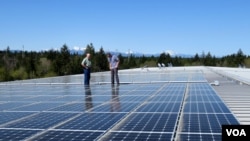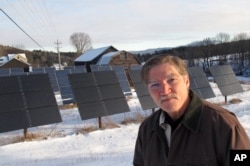Solar energy production has experienced rapid growth in the last couple of years in the United States as different business models and incentives for clean energy proliferate. But a large number of Americans currently can’t go solar even if they want to. Their houses might be shaded by trees or have unsuitable roofs. Renters and business owners in leased space are excluded, too, along with anyone who lacks the high upfront capital investment to install a respectable solar array.
But what if you could go solar without any of those hurdles?
In some places — such as the U.S., the U.K. and Germany — you can. It's called shared solar or community solar, and it's catching on.
Single mother Chris Anderson looked into adding some kind of renewable energy to her home in Shelton, Washington, but it was daunting — until last year, when her local electric company invited customers to invest in a shared solar array on the roof of the utility operations center.
"This opportunity is easy," she said. "It's literally the easy button. OK, here's the check, but I'm doing a good thing."
Anderson is one of thousands of people around the United States who've bought shares in community solar projects developed either by their utility companies or local nonprofits.
The project Anderson and her neighbors bought into sits on top of a building owned by the Mason County Public Utility District No. 3. It is a big rooftop solar array with hundreds of panels, as opposed to the 14 or so that would most likely fit on the average roof.
Justin Holzgrove, the utility's community relations manager, said the shared solar project has been incredibly popular. "We had twice as many people register for solar units as we had solar units available. There was a lot of interest in this," he said.
Payback can be great
Another advantage of shared solar is it can pay for itself in a shorter amount of time than a private home system can.
"We estimated a three-to-four-year payback period, which is fantastic," Holzgrove said. "When you're looking at putting a rooftop solar system on your own home, a private home, you're looking at a 10-to-15 maybe even a 20-year payback period, depending on your site's location."
In Washington state, public utilities have offered shares in community solar projects for as little as $100 up to a maximum of $10,000 per customer.
The math generally works out like this: The utility pays investors for their share of the electricity produced, usually as credits on their bills. In addition, a government subsidy or tax credit may be offered.
Washington state happens to offer a very generous incentive for shared solar, but it's not that way is most of the rest the country. In states with low electricity rates and no solar subsidies, the communal approach has proven a tough sell because investors may never break even over the life of a project.
But another selling point is that the community projects are a way for people who can't do solar, or who don't want the hassle, to easily do their part to fight climate change.
Opportunities and obstacles
The National Renewable Energy Laboratory estimates at least half of U.S. households are not suited for on-site solar. But government researchers say the growth potential for communal solar projects is great. Senior analyst David Feldman, the lead author on a recent report, said shared solar opens up the energy market dramatically.
"It also has a lot more potential for community support, and it's something that a lot of utilities can get behind because they are not cut out of the energy-producing process like what occurs on on-site [photo-voltaic/solar] systems."
Feldman pointed to a variety of barriers that stand in the way of community solar reaching its potential. Those include unfamiliarity with the concept and all manner of red tape that comes from the involvement of regulated utilities, government agencies, customer contracts and multiparty financing.
"If utilities or regulators don't support this type of arrangement," he said, "then it is very difficult for these businesses to come about because there is no way for the economics to work."
Government support
Feldman said the level of government support is a key indicator of success, too. Shared solar arrays are concentrated not in the sunniest U.S. states, but in those that passed specific enabling laws, such as Massachusetts, Minnesota, Colorado and Washington.
Despite impressive growth in solar energy use in recent years, the U.S. Energy Information Administration says it accounts for only about 1 percent of U.S. electricity generation today. But ideas like shared solar may give power from the sun a much wider reach and a much brighter future.
















